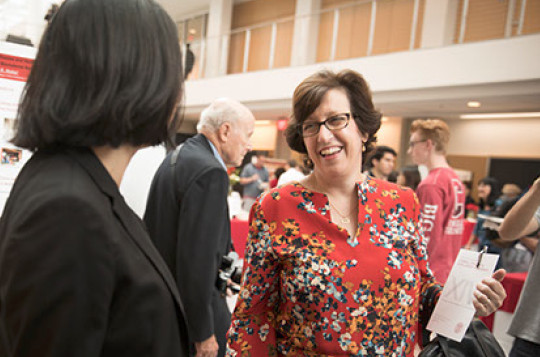When I meet Cornell alumni on campus and elsewhere, they often tell me wonderful stories about the professors and courses that helped make them who they are. You remember riveting lectures, some of them delivered flawlessly and without notes; labs that gave you your own “eureka” moment and unlocked the excitement of discovery; classmates with whom you puzzled out problem sets or brainstormed about essay topics. All these things and more were unforgettable parts of your education.

Pollack at the Festival of Scholarship during her inauguration celebration in late August.
Photo: Lindsay France/Cornell Marketing Group
What do today’s students experience? Whether you call them Gen Z, iGen, or post-Millennials, they grew up using the Internet from a very young age. For them, all sorts of information has always been just a click or two away. And we hear frequently that because these students are so tech-savvy—and so good at getting information—universities need to teach them in a different way.
Educational innovation is a high priority for me, and I believe we need to approach it holistically. Inspiring lectures have an enduring place in our pedagogy at Cornell. So do educational innovations that do not rely on technology. Spurred on by our Engaged Cornell initiative, for example, professors and students throughout the University are teaming up with community and global partners to tackle real problems, taking what they learn in the classroom and applying it out in the world. Students then sharpen their understanding by reflecting on and writing about their experiences.
But we also have been adopting new approaches to teaching in which technology plays a role. In “flipped classrooms,” for example, students do the formal prep work on their own (perhaps watching a video lecture or listening to a podcast) and then spend class time working with each other and their professors to explore the material in more depth. The goal is to develop critical thinking, creativity, problem-solving, and teamwork skills that transfer to many other subjects and settings.
My colleagues in the humanities rightly point out that they have been employing this approach all along in their seminars, utilizing class time for in-depth discussion of readings that students have done in advance. And it turns out that by using technology, the flipped approach is scalable to large courses across many disciplines. Students in such classes frequently show improvements in learning compared to those in traditionally taught classes; professors get real-time feedback on how well students understand the material and can use that data to inform their teaching.
Professor Julia Thom-Levy, who was among the pioneers who helped “flip” large physics courses as part of the College of Arts & Sciences’ Active Learning Initiative, now serves as vice provost for academic innovation. In her new role, she is working to create excitement and experimentation around teaching, rooted in evidence-based practices, and to support faculty as they design new courses or think about how they teach existing ones. With her leadership, we have created a new academic support unit, the Center for Teaching Innovation, which combines expertise in academic technology with more traditional support for faculty and teaching professionals, including graduate TAs and postdocs. The new center will offer access to videographers, instructional designers, technology experts, and experts on inclusive teaching, pedagogy, and assessment—all in one place.
Whether we are creating active learning and other innovative opportunities for residential students, developing online materials in support of our outreach mission, or augmenting our online courses and professional certificate programs through eCornell, I believe that educational innovation can help make us a national leader in this important area. All these will be on our agenda as we build on the distinguished and distinctive education that is a hallmark of Cornell.


